Women Suffrage in Canada: Examining the Fight for Equality
VerifiedAdded on 2023/01/05
|5
|1348
|89
Essay
AI Summary
This essay provides a comprehensive analysis of the women's suffrage movement in Canada, focusing on the historical context and the fight for political rights during the 20th century. It begins by highlighting the societal inequalities faced by women, who were largely excluded from the public sphere and denied basic rights. The essay then examines the need for suffrage, emphasizing the importance of women gaining a platform to voice their opinions and grievances. It traces the evolution of the movement, from the early restrictions on women's rights under British colonial rule to the gradual advancements made, such as the granting of voting rights to propertied women. The essay also addresses the resistance encountered from the male-dominated public sphere and the broader goals of the suffrage movement, including improvements in healthcare, education, and employment. It concludes by acknowledging the significance of the movement as a pivotal moment in Canadian history, uniting women across different social classes and cultures in their pursuit of political freedom and equality.
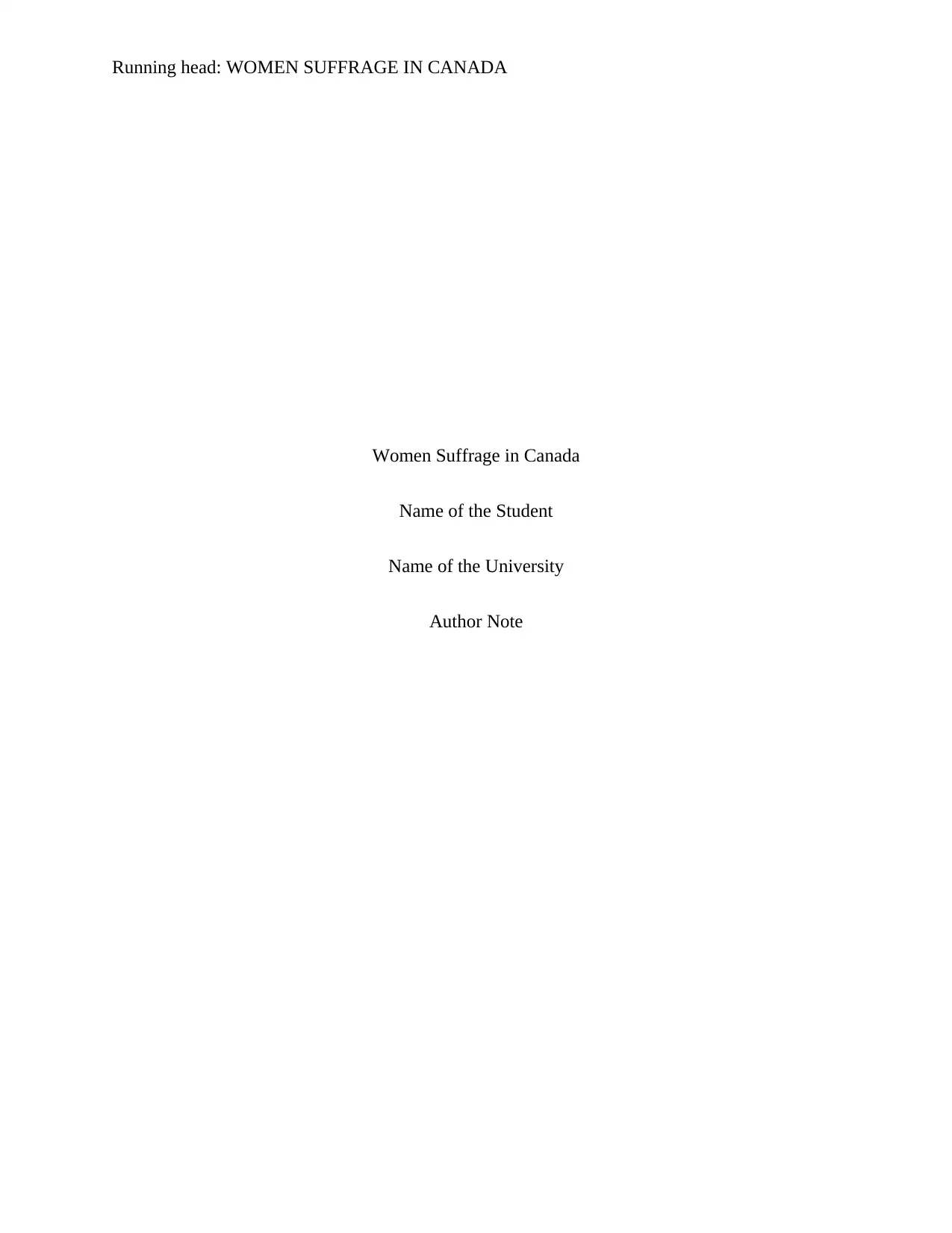
Running head: WOMEN SUFFRAGE IN CANADA
Women Suffrage in Canada
Name of the Student
Name of the University
Author Note
Women Suffrage in Canada
Name of the Student
Name of the University
Author Note
Paraphrase This Document
Need a fresh take? Get an instant paraphrase of this document with our AI Paraphraser
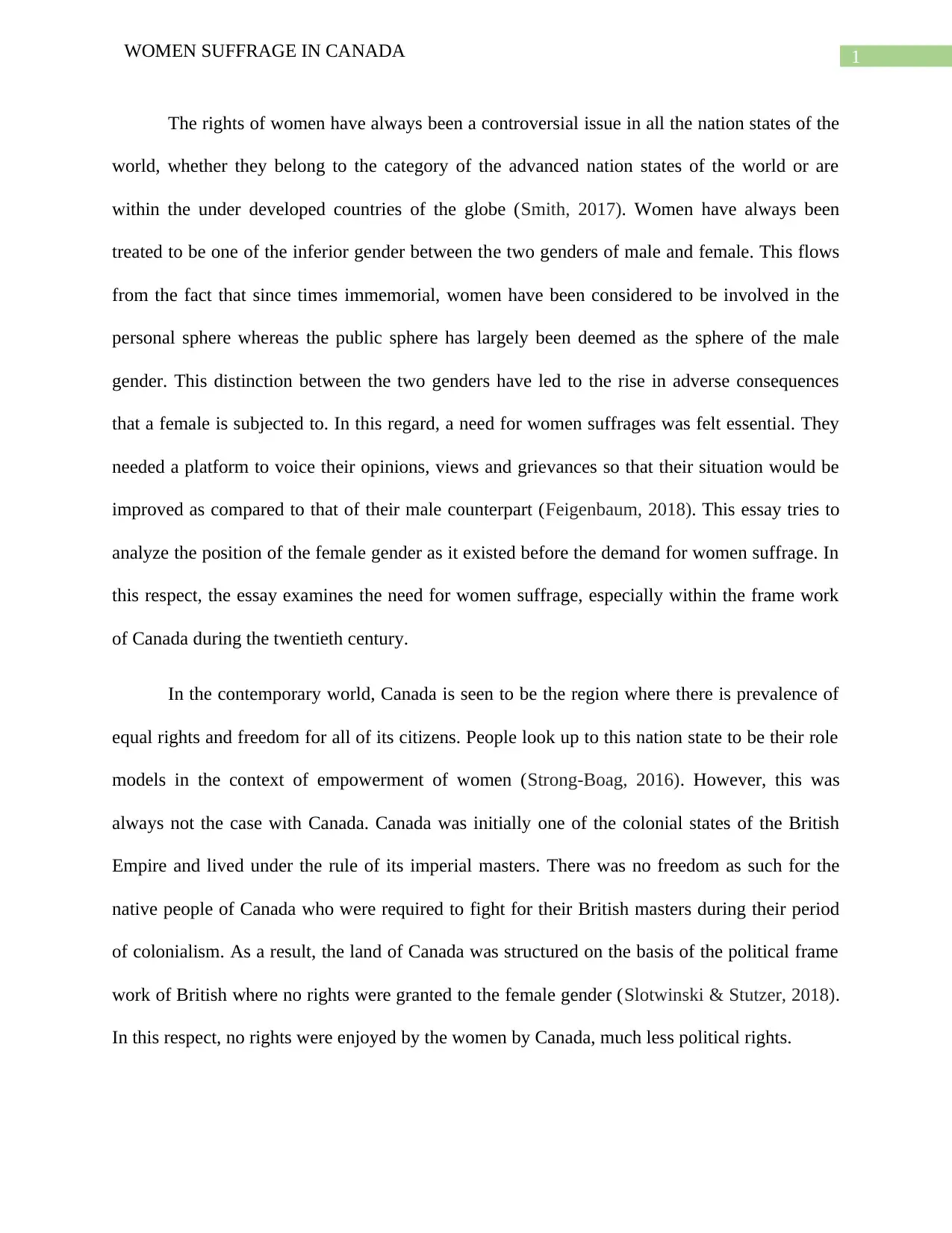
1WOMEN SUFFRAGE IN CANADA
The rights of women have always been a controversial issue in all the nation states of the
world, whether they belong to the category of the advanced nation states of the world or are
within the under developed countries of the globe (Smith, 2017). Women have always been
treated to be one of the inferior gender between the two genders of male and female. This flows
from the fact that since times immemorial, women have been considered to be involved in the
personal sphere whereas the public sphere has largely been deemed as the sphere of the male
gender. This distinction between the two genders have led to the rise in adverse consequences
that a female is subjected to. In this regard, a need for women suffrages was felt essential. They
needed a platform to voice their opinions, views and grievances so that their situation would be
improved as compared to that of their male counterpart (Feigenbaum, 2018). This essay tries to
analyze the position of the female gender as it existed before the demand for women suffrage. In
this respect, the essay examines the need for women suffrage, especially within the frame work
of Canada during the twentieth century.
In the contemporary world, Canada is seen to be the region where there is prevalence of
equal rights and freedom for all of its citizens. People look up to this nation state to be their role
models in the context of empowerment of women (Strong-Boag, 2016). However, this was
always not the case with Canada. Canada was initially one of the colonial states of the British
Empire and lived under the rule of its imperial masters. There was no freedom as such for the
native people of Canada who were required to fight for their British masters during their period
of colonialism. As a result, the land of Canada was structured on the basis of the political frame
work of British where no rights were granted to the female gender (Slotwinski & Stutzer, 2018).
In this respect, no rights were enjoyed by the women by Canada, much less political rights.
The rights of women have always been a controversial issue in all the nation states of the
world, whether they belong to the category of the advanced nation states of the world or are
within the under developed countries of the globe (Smith, 2017). Women have always been
treated to be one of the inferior gender between the two genders of male and female. This flows
from the fact that since times immemorial, women have been considered to be involved in the
personal sphere whereas the public sphere has largely been deemed as the sphere of the male
gender. This distinction between the two genders have led to the rise in adverse consequences
that a female is subjected to. In this regard, a need for women suffrages was felt essential. They
needed a platform to voice their opinions, views and grievances so that their situation would be
improved as compared to that of their male counterpart (Feigenbaum, 2018). This essay tries to
analyze the position of the female gender as it existed before the demand for women suffrage. In
this respect, the essay examines the need for women suffrage, especially within the frame work
of Canada during the twentieth century.
In the contemporary world, Canada is seen to be the region where there is prevalence of
equal rights and freedom for all of its citizens. People look up to this nation state to be their role
models in the context of empowerment of women (Strong-Boag, 2016). However, this was
always not the case with Canada. Canada was initially one of the colonial states of the British
Empire and lived under the rule of its imperial masters. There was no freedom as such for the
native people of Canada who were required to fight for their British masters during their period
of colonialism. As a result, the land of Canada was structured on the basis of the political frame
work of British where no rights were granted to the female gender (Slotwinski & Stutzer, 2018).
In this respect, no rights were enjoyed by the women by Canada, much less political rights.
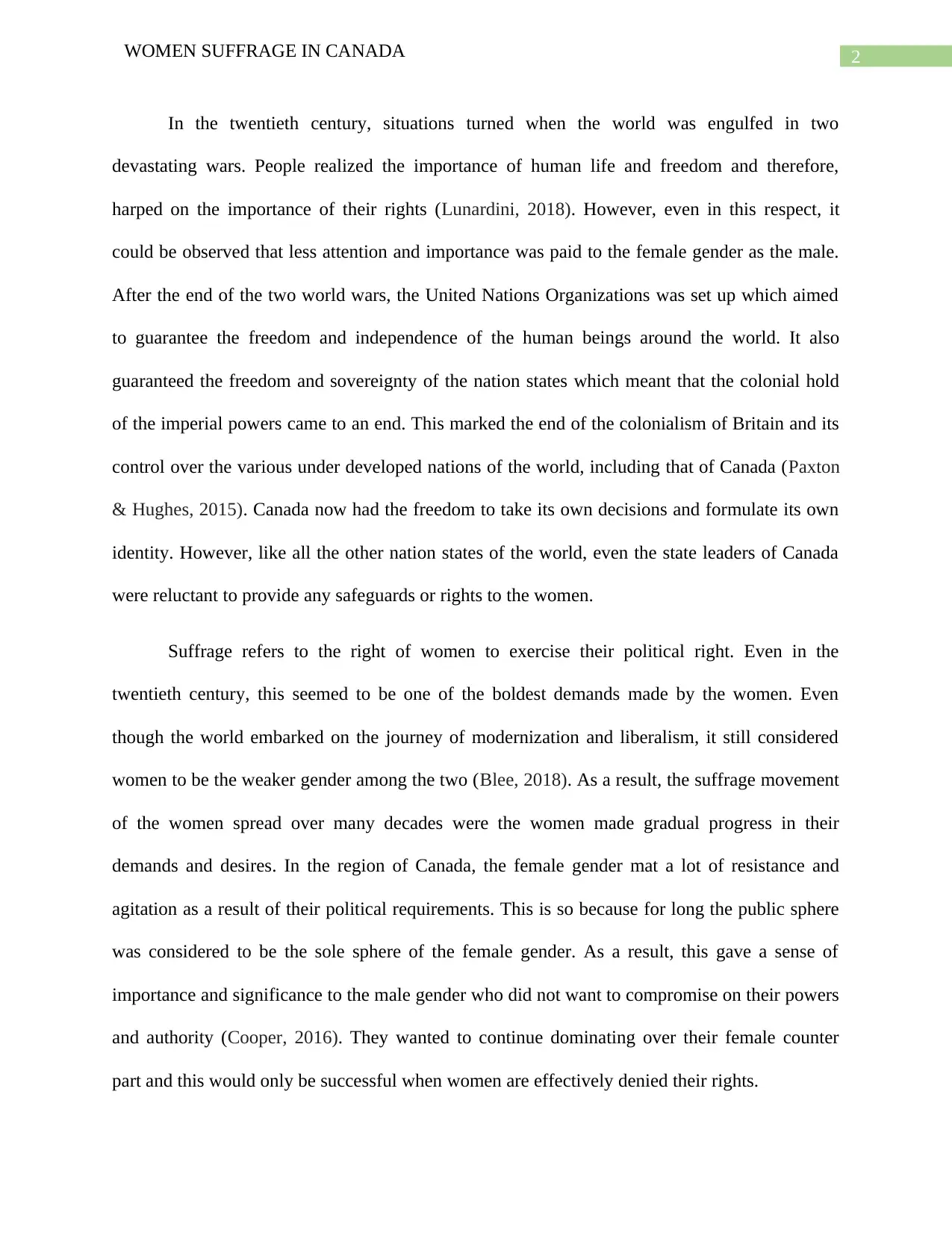
2WOMEN SUFFRAGE IN CANADA
In the twentieth century, situations turned when the world was engulfed in two
devastating wars. People realized the importance of human life and freedom and therefore,
harped on the importance of their rights (Lunardini, 2018). However, even in this respect, it
could be observed that less attention and importance was paid to the female gender as the male.
After the end of the two world wars, the United Nations Organizations was set up which aimed
to guarantee the freedom and independence of the human beings around the world. It also
guaranteed the freedom and sovereignty of the nation states which meant that the colonial hold
of the imperial powers came to an end. This marked the end of the colonialism of Britain and its
control over the various under developed nations of the world, including that of Canada (Paxton
& Hughes, 2015). Canada now had the freedom to take its own decisions and formulate its own
identity. However, like all the other nation states of the world, even the state leaders of Canada
were reluctant to provide any safeguards or rights to the women.
Suffrage refers to the right of women to exercise their political right. Even in the
twentieth century, this seemed to be one of the boldest demands made by the women. Even
though the world embarked on the journey of modernization and liberalism, it still considered
women to be the weaker gender among the two (Blee, 2018). As a result, the suffrage movement
of the women spread over many decades were the women made gradual progress in their
demands and desires. In the region of Canada, the female gender mat a lot of resistance and
agitation as a result of their political requirements. This is so because for long the public sphere
was considered to be the sole sphere of the female gender. As a result, this gave a sense of
importance and significance to the male gender who did not want to compromise on their powers
and authority (Cooper, 2016). They wanted to continue dominating over their female counter
part and this would only be successful when women are effectively denied their rights.
In the twentieth century, situations turned when the world was engulfed in two
devastating wars. People realized the importance of human life and freedom and therefore,
harped on the importance of their rights (Lunardini, 2018). However, even in this respect, it
could be observed that less attention and importance was paid to the female gender as the male.
After the end of the two world wars, the United Nations Organizations was set up which aimed
to guarantee the freedom and independence of the human beings around the world. It also
guaranteed the freedom and sovereignty of the nation states which meant that the colonial hold
of the imperial powers came to an end. This marked the end of the colonialism of Britain and its
control over the various under developed nations of the world, including that of Canada (Paxton
& Hughes, 2015). Canada now had the freedom to take its own decisions and formulate its own
identity. However, like all the other nation states of the world, even the state leaders of Canada
were reluctant to provide any safeguards or rights to the women.
Suffrage refers to the right of women to exercise their political right. Even in the
twentieth century, this seemed to be one of the boldest demands made by the women. Even
though the world embarked on the journey of modernization and liberalism, it still considered
women to be the weaker gender among the two (Blee, 2018). As a result, the suffrage movement
of the women spread over many decades were the women made gradual progress in their
demands and desires. In the region of Canada, the female gender mat a lot of resistance and
agitation as a result of their political requirements. This is so because for long the public sphere
was considered to be the sole sphere of the female gender. As a result, this gave a sense of
importance and significance to the male gender who did not want to compromise on their powers
and authority (Cooper, 2016). They wanted to continue dominating over their female counter
part and this would only be successful when women are effectively denied their rights.
⊘ This is a preview!⊘
Do you want full access?
Subscribe today to unlock all pages.

Trusted by 1+ million students worldwide
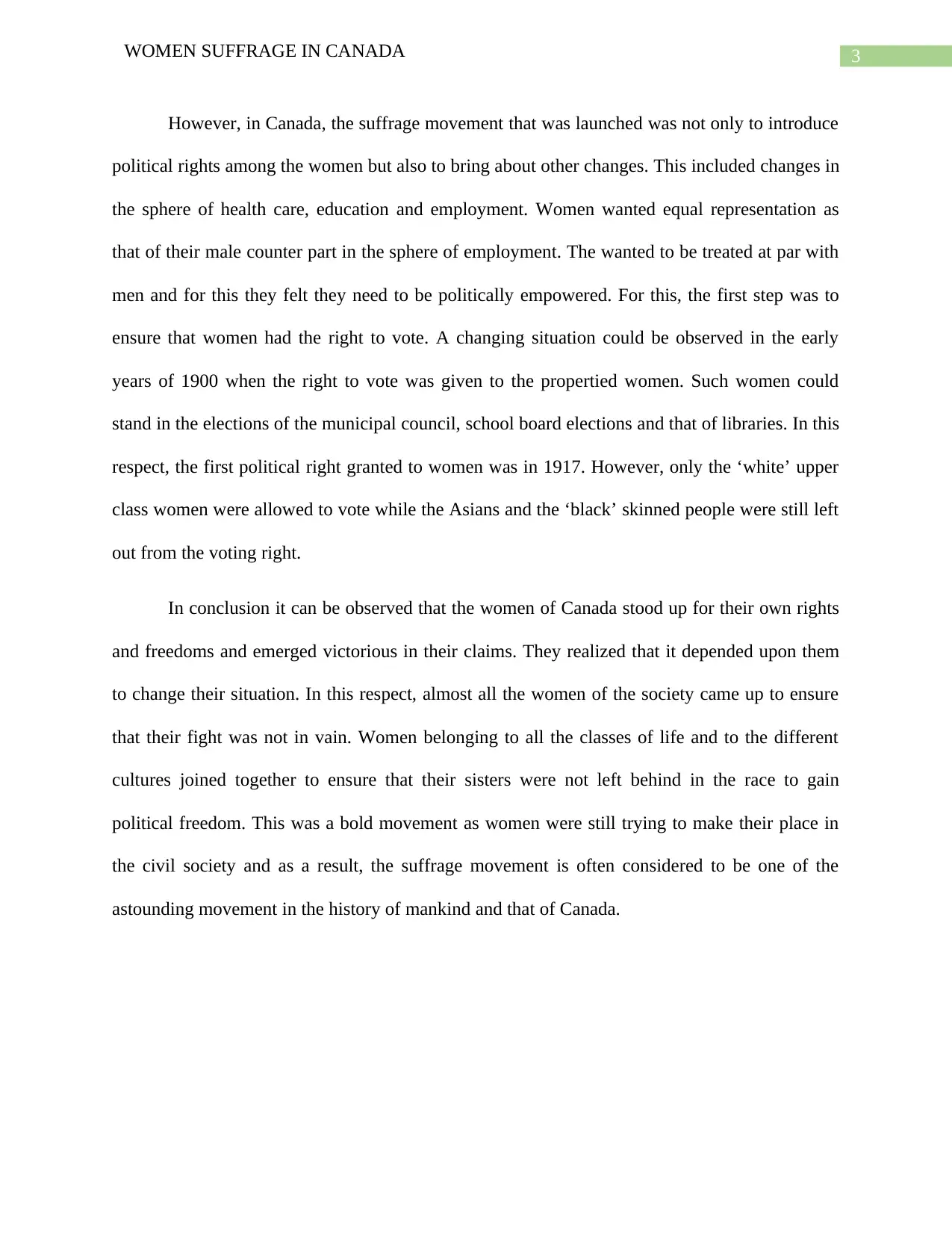
3WOMEN SUFFRAGE IN CANADA
However, in Canada, the suffrage movement that was launched was not only to introduce
political rights among the women but also to bring about other changes. This included changes in
the sphere of health care, education and employment. Women wanted equal representation as
that of their male counter part in the sphere of employment. The wanted to be treated at par with
men and for this they felt they need to be politically empowered. For this, the first step was to
ensure that women had the right to vote. A changing situation could be observed in the early
years of 1900 when the right to vote was given to the propertied women. Such women could
stand in the elections of the municipal council, school board elections and that of libraries. In this
respect, the first political right granted to women was in 1917. However, only the ‘white’ upper
class women were allowed to vote while the Asians and the ‘black’ skinned people were still left
out from the voting right.
In conclusion it can be observed that the women of Canada stood up for their own rights
and freedoms and emerged victorious in their claims. They realized that it depended upon them
to change their situation. In this respect, almost all the women of the society came up to ensure
that their fight was not in vain. Women belonging to all the classes of life and to the different
cultures joined together to ensure that their sisters were not left behind in the race to gain
political freedom. This was a bold movement as women were still trying to make their place in
the civil society and as a result, the suffrage movement is often considered to be one of the
astounding movement in the history of mankind and that of Canada.
However, in Canada, the suffrage movement that was launched was not only to introduce
political rights among the women but also to bring about other changes. This included changes in
the sphere of health care, education and employment. Women wanted equal representation as
that of their male counter part in the sphere of employment. The wanted to be treated at par with
men and for this they felt they need to be politically empowered. For this, the first step was to
ensure that women had the right to vote. A changing situation could be observed in the early
years of 1900 when the right to vote was given to the propertied women. Such women could
stand in the elections of the municipal council, school board elections and that of libraries. In this
respect, the first political right granted to women was in 1917. However, only the ‘white’ upper
class women were allowed to vote while the Asians and the ‘black’ skinned people were still left
out from the voting right.
In conclusion it can be observed that the women of Canada stood up for their own rights
and freedoms and emerged victorious in their claims. They realized that it depended upon them
to change their situation. In this respect, almost all the women of the society came up to ensure
that their fight was not in vain. Women belonging to all the classes of life and to the different
cultures joined together to ensure that their sisters were not left behind in the race to gain
political freedom. This was a bold movement as women were still trying to make their place in
the civil society and as a result, the suffrage movement is often considered to be one of the
astounding movement in the history of mankind and that of Canada.
Paraphrase This Document
Need a fresh take? Get an instant paraphrase of this document with our AI Paraphraser
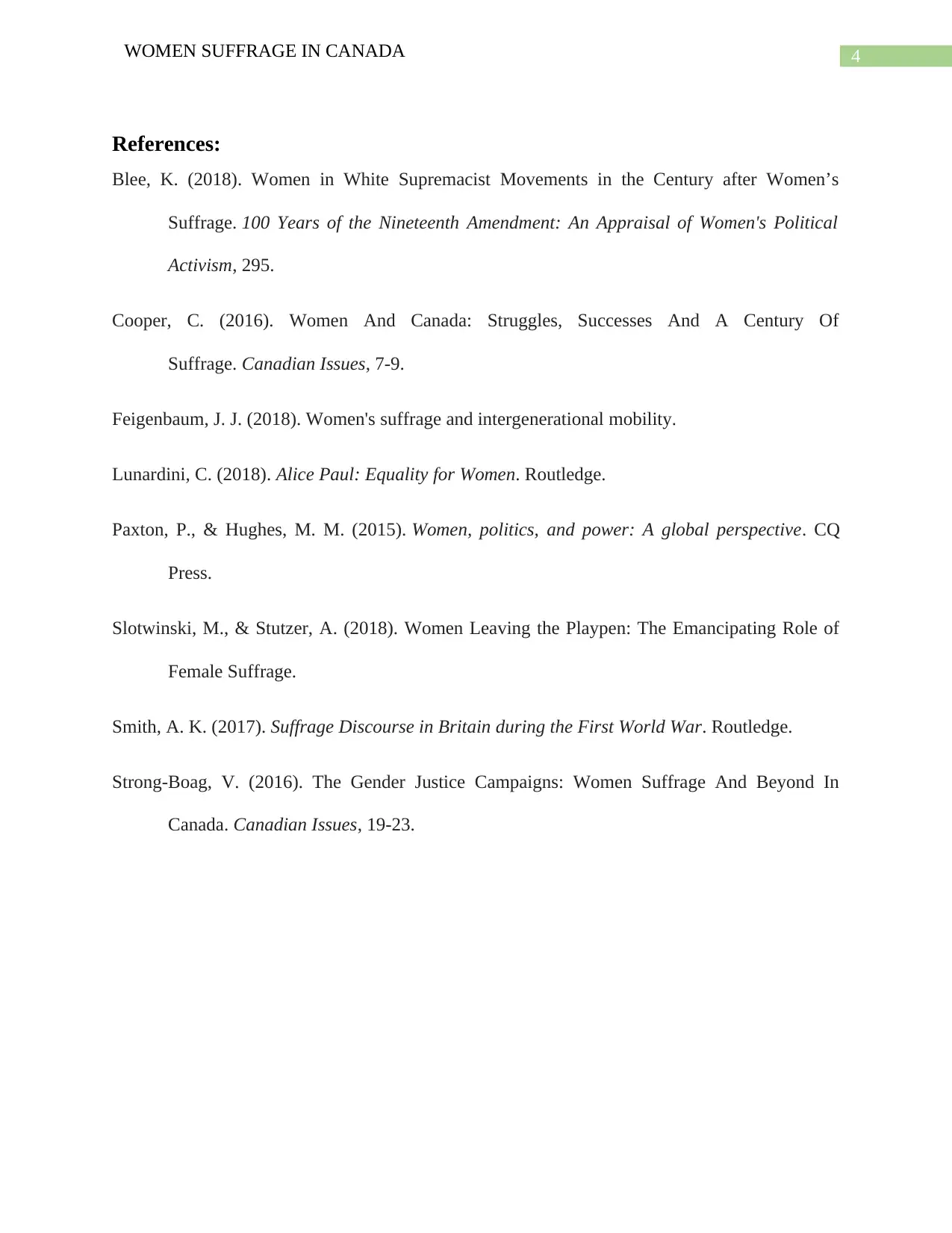
4WOMEN SUFFRAGE IN CANADA
References:
Blee, K. (2018). Women in White Supremacist Movements in the Century after Women’s
Suffrage. 100 Years of the Nineteenth Amendment: An Appraisal of Women's Political
Activism, 295.
Cooper, C. (2016). Women And Canada: Struggles, Successes And A Century Of
Suffrage. Canadian Issues, 7-9.
Feigenbaum, J. J. (2018). Women's suffrage and intergenerational mobility.
Lunardini, C. (2018). Alice Paul: Equality for Women. Routledge.
Paxton, P., & Hughes, M. M. (2015). Women, politics, and power: A global perspective. CQ
Press.
Slotwinski, M., & Stutzer, A. (2018). Women Leaving the Playpen: The Emancipating Role of
Female Suffrage.
Smith, A. K. (2017). Suffrage Discourse in Britain during the First World War. Routledge.
Strong-Boag, V. (2016). The Gender Justice Campaigns: Women Suffrage And Beyond In
Canada. Canadian Issues, 19-23.
References:
Blee, K. (2018). Women in White Supremacist Movements in the Century after Women’s
Suffrage. 100 Years of the Nineteenth Amendment: An Appraisal of Women's Political
Activism, 295.
Cooper, C. (2016). Women And Canada: Struggles, Successes And A Century Of
Suffrage. Canadian Issues, 7-9.
Feigenbaum, J. J. (2018). Women's suffrage and intergenerational mobility.
Lunardini, C. (2018). Alice Paul: Equality for Women. Routledge.
Paxton, P., & Hughes, M. M. (2015). Women, politics, and power: A global perspective. CQ
Press.
Slotwinski, M., & Stutzer, A. (2018). Women Leaving the Playpen: The Emancipating Role of
Female Suffrage.
Smith, A. K. (2017). Suffrage Discourse in Britain during the First World War. Routledge.
Strong-Boag, V. (2016). The Gender Justice Campaigns: Women Suffrage And Beyond In
Canada. Canadian Issues, 19-23.
1 out of 5
Related Documents
Your All-in-One AI-Powered Toolkit for Academic Success.
+13062052269
info@desklib.com
Available 24*7 on WhatsApp / Email
![[object Object]](/_next/static/media/star-bottom.7253800d.svg)
Unlock your academic potential
Copyright © 2020–2025 A2Z Services. All Rights Reserved. Developed and managed by ZUCOL.





